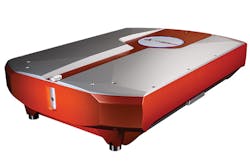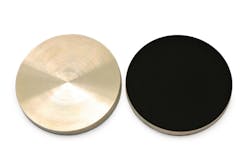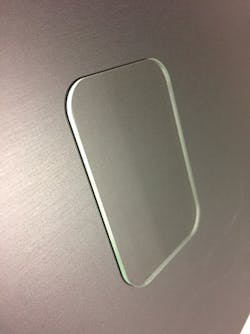Beam shaping, functionalization, and handling increases quality and throughput
ERIC MOTTAY
Ultrafast lasers have gained wide acceptance over the past several years as a unique tool for advanced high-precision manufacturing (FIGURE 1). Their ability to process virtually any material without thermal effect has opened many new industrial applications, as diverse as medical device manufacturing, high-speed glass cutting, or semiconductor dicing, to name only a few.
A key advantage of ultrafast laser microprocessing is the absence of thermal effects. In most laser processes, heat absorption and subsequent energy transfer to the matrix lead to material ablation. Ultrafast laser processing relies on short pulse duration and high optical intensity to ionize the irradiated volume, which is then ejected before any heat diffusion can occur. Laser ablation is mostly confined to the laser-irradiated volume, and is therefore extremely precise. However, this also means that compared with traditional laser processes, the quantity of ablated matter is extremely small. Initial applications of ultrafast lasers were therefore limited to niche markets, requiring extremely high accuracy without significant productivity requirements.
The need for high industrial process throughput has been a key development driver since the inception of industrial ultrafast laser technology. The most immediate approach is to increase the laser average power. If a single laser pulse removes a given amount of material, then increasing the laser repetition rate—that is, the number of pulses per second—will immediately improve the process efficiency.
Evolution of ultrafast lasers
The first generation of industrial ultrafast lasers delivered an average power in the range of 1 to 10W. Over the past 10 years, three different approaches have been developed to overcome this limitation. Microstructured optical fibers, by offering a large mode area and single transverse mode propagation, spread the heat generated over the whole fiber length, enabling high-average-power operation. Thin disk technology offers high energy per pulse, and therefore higher average power, at the expense of some limitations in pulse repetition rates.
More recently, slab technology also offers a very significant potential by combining large beam cross-section and multi-pass amplification. All technologies have led to commercial products in the 100W range, as well as laboratory demonstrations up to average powers exceeding 1kW—sufficient to cover most existing applications.
However, laser power alone is not sufficient to guarantee high-throughput processing. For instance, even if the laser-matter interaction is virtually athermal in the sub-picosecond domain, heat accumulation may occur when operating the laser at high repetition rate. Heat accumulation comes from the fact that the residual amount of absorbed heat in a single pulse, even if very small, cannot be dissipated before the next laser pulse hits the same position on the material. A possible mitigation is to make sure that the laser beam is moving fast enough to prevent local heat accumulation. However, this requires a higher speed than is easily achievable with conventional galvanometric scanners.
Polygon scanning
The past few years have seen the resurgence of the concept of polygon scanners applied to ultrafast laser processing. Allowing linear scanning speed >100m/s, polygon scanners can achieve high productivity while maintaining the high quality of ultrafast laser micromachining. Because they operate in a fundamentally different way than traditional scanners, offering high speed in a single dimension only, they are uniquely suited to high-speed, high-area surface processing and milling, or the drilling of multi-hole patterns with a high quality.
Taking advantage of all opportunities for high throughput processing with a polygon scanner requires high laser power, as well as advanced temporal engineering of the beam. Rapid on-and-off switching of the laser pulse, as well as very precise synchronization between the laser repetition rate and the polygon rotation, is essential to make sure that the laser beam hits precisely the same position in each polygon facet at every rotation.
Surface processing applications can benefit from the development of high-speed polygon scanning technology (FIGURE 2). Ultrafast lasers can, for instance, modify the surface of metals to achieve a deep, beautiful black coloration without any chemical treatment (FIGURE 3). This is limited to applications such as the marking of luxury goods like high-end watches, or small consumer electronics devices.
Increasing the texturing speed can open new markets. Surface texturing of silicon can also drastically increase its absorbance, allowing for higher photon-to-electron conversion efficiency. Currently implemented on small-size infrared photodetectors, a higher processing speed could bring high-efficiency solar cells to the market.
Beam multiplexing and shaping
Another way to increase the throughput in industrial applications is to take advantage of the high pulse energy available from current industrial ultrafast lasers by splitting the laser beam into multiple beamlets. In many applications, a pulse energy of a few microjoules is sufficient to process the material. Current high-power ultrafast lasers have a pulse energy of a few hundred microjoules. Beam multiplexing can be achieved using spatial light modulators for maximal flexibility, or fixed diffractive optical elements for optimal efficiency.
In yet another example, glass cutting is one of the most important, yet challenging applications for ultrafast lasers (FIGURE 4). Current technologies, using mechanical means, have strong limitations when dealing with thin, tempered, or multilayer glasses. Ultrafast lasers can provide the quality needed, but usually at the expense of processing speed.
The recent development of beam shaping using non-diffractive Bessel beams allows the creation of an elongated focus, with a radius of a few tens of microns maintained over a length exceeding 1mm. Coupled with temporal shaping such as burst mode operation, this process has led to a variety of ways to cut thick, multilayer glasses at high speed, and is still an active field of research and development.
The demand for greater integration in microelectronics drives the need for advanced 3D packaging. New methods for connecting different vertically separated layers are necessary to meet this need. A thin interposer, made of silicon and glass, perforated by millions of micro-holes provides a high connection density as well as a physical separation between layers. To manufacture this component, it is necessary to create multiple micro-holes with a very high speed. Typically, holes measuring 10–30μm diameter, with a pitch of 30 to 100μm, must be drilled in a 100μm or less glass plate at a speed of 5000 to 10000 holes/s. Combining high-power ultrafast lasers, beam shaping technology, and beam multiplexing with diffractive optical elements will again enable significant advances in terms of processing quality and speed.
The current generation of industrial lasers, with average power exceeding 100W, has broken an important barrier to industrial applications by providing the potential for high-throughput processing. However, to take full advantage of the laser source, beam engineering—that is, the shaping, functionalization, or handling of the beam between the laser output and the workpiece—has become an essential field of research and development.
ERIC MOTTAY([email protected]) is the president and CEO of Amplitude Systèmes, Pessac, France; www.amplitude-systemes.com. He is also a periodic contributor on ultrafast laser processing for ILS.




